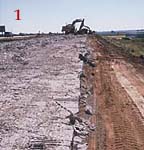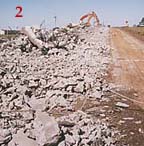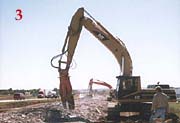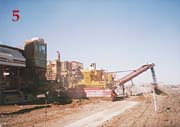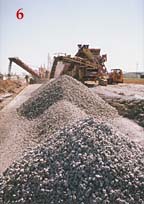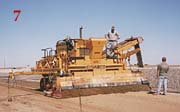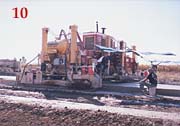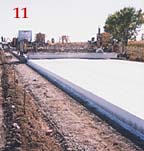GOMACO World Index --- GOMACO World 27.4 - January 2000
The Paradigm
Manatts, Inc., based out of Brooklyn, Iowa, has named their innovation, a mobile crusher, "The Paradigm."
"Paradigm is a frame of mind you're in where the crusher has to be setting in a quarry base, stationary. The industry's been in a paradigm forever where you cannot move and crush in the same motion," Duane McDonald, Division Manager for Concrete Paving at Manatts, said. "Now we've taken the step where we feel we need to come out of that paradigm and come into the new millennium thinking that we can crush on the run."
Manatts took parts and tracks off old and salvaged equipment and attached them to their crusher. "We took some of the ingenuity that has already been spent on this industry and put it onto another machine," McDonald said.
Here's how the process worked on the Interstate 35 project:
1. A truck-mounted, segmented-head breaker breaks up the existing roadway.
2. An excavator equipped with ripper hooks pull the steel to the surface of the rubblized roadway. It is left there in a windrow. The next excavator, mounted with a demolition jaw, breaks any concrete off the rebar that is left attached after the breaker rubblized.
3. A third excavator with a cutter cuts the rebar down to size and loads the iron onto the transports to be taken to the salvage yards for recycling.
4. The Paradigm and a GOMACO 9500 trimmer work together on the subgrade. The Paradigm crushes the concrete pieces down to approximately 38mm (1.5 in) and deposits the material out the back of the machine. The Paradigm's legs are self-leveling and allow the machine to maintain a constant gradation. It has an average production rate of 3.66m (12 ft) per minute.
5. Running along side of the crusher is the 9500. It trims a one-lane path next to the crusher and trims the dirt to grade. A roll of geogrid plastic mesh material is mounted to the back of the trimmer and is spread out as the 9500 moves along.
The geogrid has a dual purpose. "In our process of making the road smooth, we take out any horizontal deviation that was left in the original subgrade. We can be trimming up to 102mm (four inches) of select backfill off the subgrade to make these corrections. The select backfill is vital to the support of future pavements," McDonald said. "Geogrid replaces the loss of the select backfill that was removed and adds to the strength of the granular subbase."
6. Crushed rock from the Paradigm is deposited directly onto the plastic geogrid. "With the 9500 running next to the Paradigm, we can deposit the material, handled only once, on finished grade," McDonald said. "The efforts of additional trucking, labor, material, and machine costs are taken clear out of the formula for a cost savings to whatever client or contracting authority we're working for."
7. Two other 9500s follow behind in the lane where the Paradigm is working and trim dirt to grade.
8. The 9500s were trimming 4.88m (16 ft) wide and made average cuts of 102 to 152mm (four to six inches). Production averaged between 549 to 671m (1800 to 2200 ft) per day. "There are days you're up around 762m (2500 ft), but on an interstate project where you're jumping exit ramps, it gets very time consuming," McDonald said. "Our average between 549 to 671m (1800 to 2200 ft) is very livable and we accept that as a good day."
9. The windrowed, recycled rock is spread evenly across the grade by bulldozers. Water is added and the material is compacted. The two 9500s then trim the granular material to line and grade.
10. Manatts used their two-track GOMACO paver and T/C-600 texture/cure for the paving portion of the project. By spec the road is 7.8m (25.59 ft) wide, 300mm (11.81 in) thick and the baskets are spaced at six meters (19.69 ft).
An Iowa Department of Transportation (IDOT) proven concrete mix containing fly ash was used for the interstate. Dump trucks hauled the concrete to the job site from a mobile batch plant 8.05km (five miles) away. Concrete slump was 38mm (1.5 in).
Production averaged around 1158m (3800 ft) per day. "We try not to let production set the pace," McDonald said. "We try to make quality set the pace."
Their philosophy is working. The highest average rideability reading Manatts had on the project was 33mm (1.3 in). "It's fair for me to say that we ended up with a better than 33mm (1.3 in) smoothness," McDonald said. "It's all due to the paver, the people that manufacture it and the people that run it.
"If the concrete paver can't lay the concrete smooth enough, I can assure you the finishers will not be able to keep up with the pace," McDonald said. "It all has to do with the paver, the machine putting it down."
McDonald also likes the sharp GOMACO edges. "This paver puts out the best edge of any paver I've ever been around.
"GOMACO machines happen to be our favorites. We can't say enough good things about the company," McDonald said. "We're really pleased that GOMACO is an Iowa-based company that provides the kind of service and equipment that they have for the paving industry."
11. Another innovation on the project was the way the slab was finished. "IDOT changed the spec this year from transverse to longitudinal tining," McDonald said. "We all really like it. Now we can actually texture and cure in the same motion."
Manatts has owned their T/C-600 since 1984. "This machine has seen some miles," McDonald said. "It's been a good and dependable machine."
Approximately 29km (18 mi) of 7.32m (24 ft) wide and 203mm (eight inch) thick roadway was torn out, recycled and paved again between April and October of this year.
In mid-October, Manatts had to stop work on the $19 million interstate project with only 1.45km (0.9 mi) left on the contract. "We had to stop because of the football season," McDonald said. "It's not that we couldn't get it done. We had all sorts of time, but it was a traffic control issue for the football season in the Ames area."
Work will resume and be finished in the Spring of next year. "It was bid as a two year contact and I would assume if we had done it the old, the permanent crusher style, it would have taken two seasons to do the job," McDonald said. "It's probably a stretch to say that we saved a year, but it would have taken a good portion of another construction season to have finished this project."
Subscribe to Receive GOMACO World Magazine
